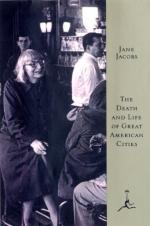|
This section contains 612 words (approx. 2 pages at 400 words per page) |

|
Part 1, Chapter 6, The Uses of City Neighborhoods Summary and Analysis
The city neighborhood is also a unit that is studied by Jacobs. A successful city neighborhood determines what its problems are and takes steps to solve them. An unsuccessful city neighborhood is one that doesn't do this, but is instead overcome by the problems. Cities are comprised of all combinations of these successes and failures. A good neighborhood is not dependent on economic class. Neighborhood success is a function of neighborhood self-government and self-management.
City planners view a neighborhood as an introverted group of about 7,000 people. This is large enough to support a grade school, a community center, and convenience shopping. This is the ideal sized planned neighborhood. They can't recreate the small town atmosphere where people grew up together, went to school together, and have known each other...
(read more from the Part 1, Chapter 6, The Uses of City Neighborhoods Summary)
|
This section contains 612 words (approx. 2 pages at 400 words per page) |

|




